Understanding Large Numbers
1. Place Values in the Indian Number System
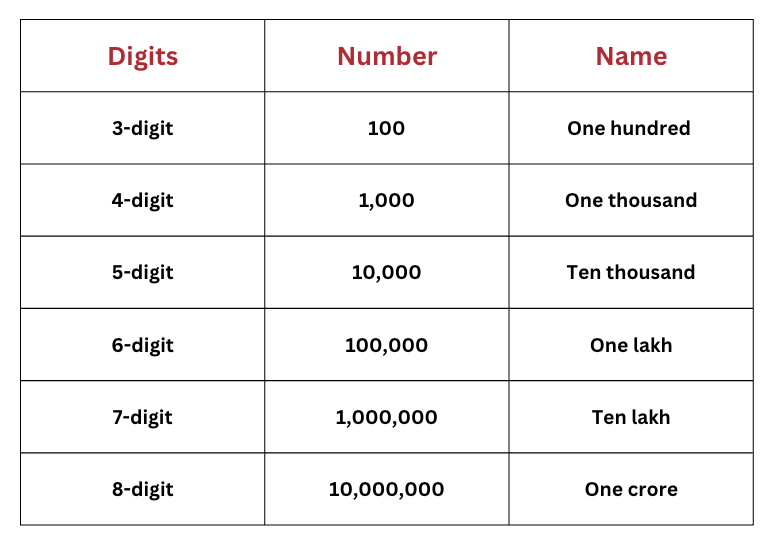
1 Lakh = 1,00,000
1 Crore = 1,00,00,000
1 Billion = 100 Crores = 1,00,00,00,000
2. Number Names
12,78,830 → Twelve lakh seventy-eight thousand eight hundred thirty
15,75,000 → Fifteen lakh seventy-five thousand
Comparing Indian and International Number Systems

1. Indian Commas Pattern: 3-2-2 pattern
- Start from the right.
- First, place a comma after 3 digits.
- Then, place a comma after every 2 digits.
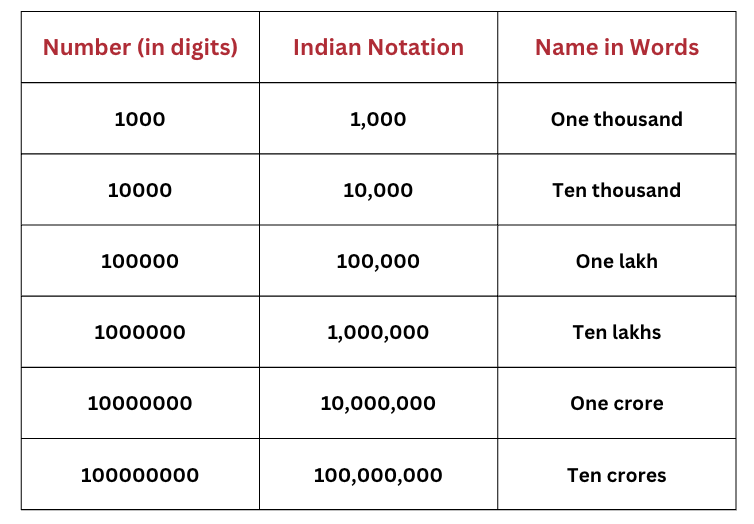
2. International Commas Pattern: 3-3-3 pattern
- Start from the right.
- Place a comma after every 3 digits.
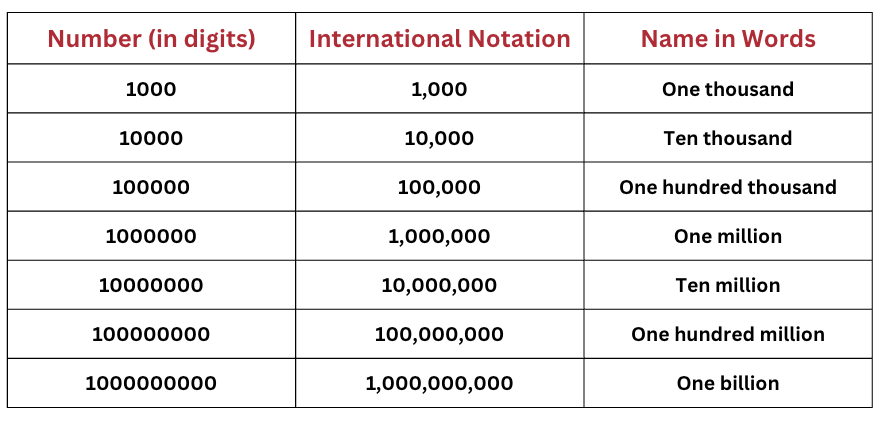
Quick Math Facts
1. Multiplying by power of 10
Add zeroes according to the number of zeroes in 10, 100, 1000, etc.
245 × 10 = 2450
245 × 100 = 24,500
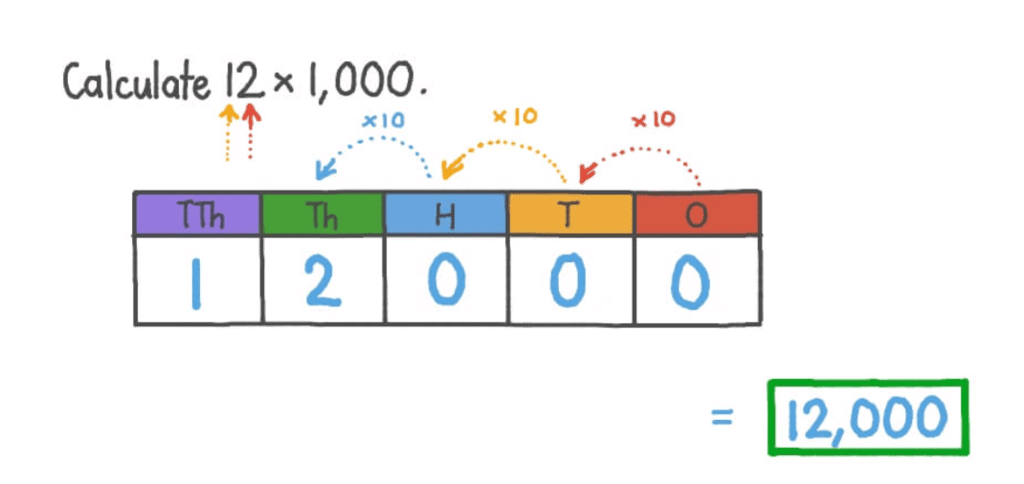
2. Shortcuts
×5 → Divide by 2 and multiply by 10
×25 → Multiply by 100 and divide by 4
×125 → Multiply by 1000 and divide by 8
Examples:
116 × 5 = (116 ÷ 2) × 10 = 58 × 10 = 580
824 × 25 = (824 × 100) ÷ 4 = 82,400 ÷ 4 = 20,600
Estimation & Approximation
1. What is Approximation?
Approximation means rounding a number to make it easier to use.
We use approximation when:
A number is too long or hard
We want a simpler answer
Rounding OFF
Round up when safety or excess is needed (e.g., food orders)
Round down when you want a lower or conservative estimate.

Rounding Examples
Round 6,72,85,183 to nearest thousand → 6,72,85,000
Round to nearest crore → 7,00,00,000
2. What is Estimation?
Estimation means finding a number that is close to the exact answer, but not exact.
We use estimation when:
We want to save time
We don’t need the exact number
We just need a rough idea
Example:
Q: What is 298 + 705?
Estimate:
298 is close to 300
705 is close to 700
Estimated total = 300 + 700 = 1000
Calculator Challenges (Button Press Logic)
1. +1000 Calculator (Thoughtful Thousands)
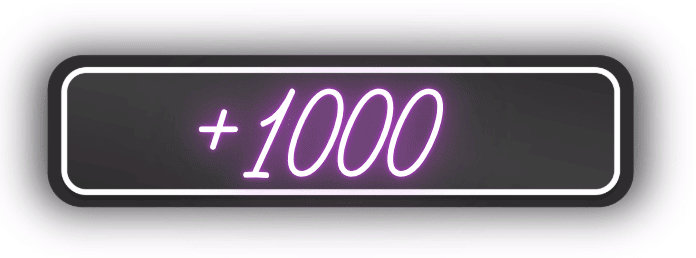
This calculator adds 1,000 every time you press the button.
Examples:
To reach 10,000, press it 10 times
→ 1,000 × 10 = 10,000To reach 1,00,000, press it 100 times
→ 1,000 × 100 = 1,00,000
2. +100 Calculator (Handy Hundreds)
This calculator adds 100 with each press.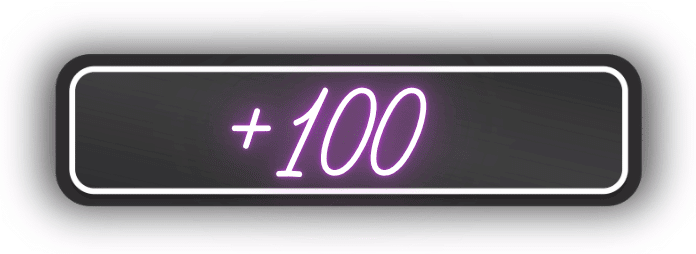
Examples:
To reach 10,000, press it 100 times
→ 100 × 100 = 10,000To reach 1,00,000, press it 1,000 times
→ 100 × 1,000 = 1,00,000
3. +10 Calculator (Tedious Tens)
This one adds only 10 per press.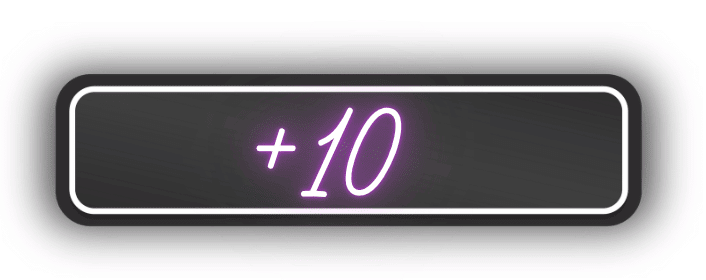
Examples:
To reach 10,000, press it 1,000 times
→ 10 × 1,000 = 10,000To reach 1,00,000, press it 10,000 times
→ 10 × 10,000 = 1,00,000
Patterns in Multiplication
1. Interesting Number Patterns
11 × 11 = 121
111 × 111 = 12321
101 × 101 = 10201
2. Digits in Multiplication Results
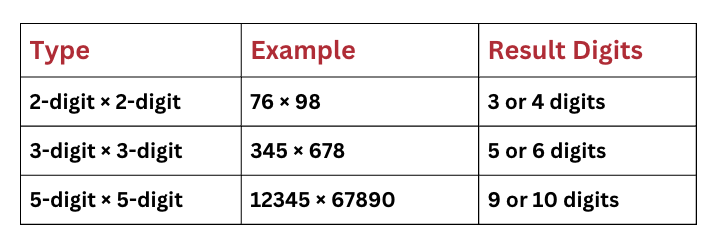
Problem Solving & Logical Reasoning
Example 1: Walking to the Moon?
Question: If someone walks 100 km every day, how far would they travel in 10 years?
Step-by-step logic:
1 year = 365 days
So, 10 years = 365 × 10 = 3,650 days
Distance per day = 100 km
Total distance = 100 × 3,650 = 3,65,000 km
Now compare with the distance to the Moon:
The average distance to the Moon = 3,84,400 km
Conclusion:
You're almost there! Just 19,400 km short.
Example 2: Counting 1 Million Coins
Question: If you count 1 coin per second, how long will it take to count 1 million coins?
Step-by-step logic:
1 million = 1,000,000 coins
1 second per coin = 1,000,000 seconds
Let’s convert seconds to days:
1 minute = 60 seconds
1 hour = 60 minutes = 3,600 seconds
1 day = 24 hours = 86,400 seconds
Now divide:
1,000,000 ÷ 86,400 ≈ 11.57 days
Conclusion:
It would take almost 11.5 days (without sleeping or stopping!) to count 1 million coins.


















